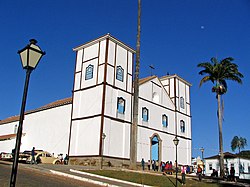Pirenópolis
| Pirenópolis | |||
|---|---|---|---|

Matrix Church of Ours Lady of the Rosary
|
|||
|
|||
| Nickname(s): Cradle of the Goiana Press, rare Jewel of the center-west | |||
 Location of Pirenópolis |
|||
| Coordinates: 15°51′07″S 48°57′32″W / 15.85194°S 48.95889°WCoordinates: 15°51′07″S 48°57′32″W / 15.85194°S 48.95889°W | |||
| Country | Brazil | ||
| Region | Centre-West | ||
| State | Goiás | ||
| Founded | 7 October 1727 | ||
| Government | |||
| • Mayor | Nivaldo Antônio de Melo | ||
| Elevation | 770 m (2,530 ft) | ||
| Population (2007) | |||
| • Total | 20,460 | ||
| Website | Official site | ||
Pirenópolis is a town located in the Brazilian state of Goiás. It is well known for its waterfalls and colonial architecture, and a popular festival involving mounted horses called Festa do Divino Espírito Santo which takes place 45 days after Easter.
The history of Pirenópolis begins in 1727 when it was founded with the name of Minas de Nossa Senhora do Rosário de Meia Ponte, Meia Ponte (half a bridge) because half of the bridge over the Almas River was swept away in a flood. The first colonizers were Portuguese who came for the gold easily found in the Rio das Almas. From 1750 to 1800 there was a golden age when four churches were built and Pirenópolis competed with Vila Boa (present day Cidade de Goiás) as the richest town in the province. After 1800 a downturn over gold mining was set and the part of the population emigrated. With the change of commercial routes to Anápolis, the city became economically isolated. The first newspaper in the province, the Matutina Meiapontense, was published in Meia Ponte in 1830 by Joaquim Alves de Oliveira. In 1890 the city changed its name from Meia Ponte to Pirenópolis, the city of the Pireneus, the mountains located nearby. In 1960 with the construction of Brasília there was an intensive exploitation of the famous Pedra de Pirenópolis (quartzite-micáceo). In the 1980s the hippies arrived with their alternative communities and production of handicrafts. Pirenópolis was born again with a huge influx of tourists, especially from Brasília. Churches were restored and all the electrical wiring was put underground.
Pyrenópolis (archaic orthography), later Pirenópolis , means in Greek “the City of the Pireneus”. Its name comes from the mountain range that surrounds the city, that is Mountain range of the Pireneus . According to local tradition, the mountain range received this name for having in the region immigrant Spaniards, probably Catalans. Because of some similarity with their native Pyrenees of Europe, a mountain chain situated between Spain and France, they had then given this mountain range the Latin name of Pireneus.
...
Wikipedia


